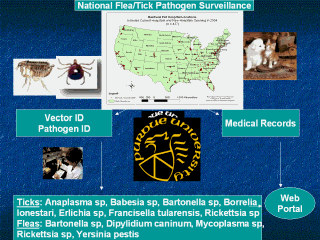| front |1 |2 |3 |4 |5 |6 |7 |8 |9 |10 |11 |12 |13 |14 |15 |16 |17 |18 |19 |20 |21 |22 |23 |24 |25 |26 |27 |28 |29 |30 |31 |32 |33 |review |
 |
· A National
Flea/Tick Surveillance Program was created using the medical records of dogs
and cats seen by Banfield veterinarians in 44 states · The latitude and longitude of the home address of dogs with recorded tick infestation can be used to monitor tick activity over time for specific geographic areas and to identify significant time-space clusters · Ticks collected from infested dogs by veterinarians can be sent to a laboratory where their species is determined and multiplex PCR used to identify specific potential human pathogens · This system can be used to identify geographic areas in need of public health education regarding tick borne diseases or areas that should be sprayed for ticks. |